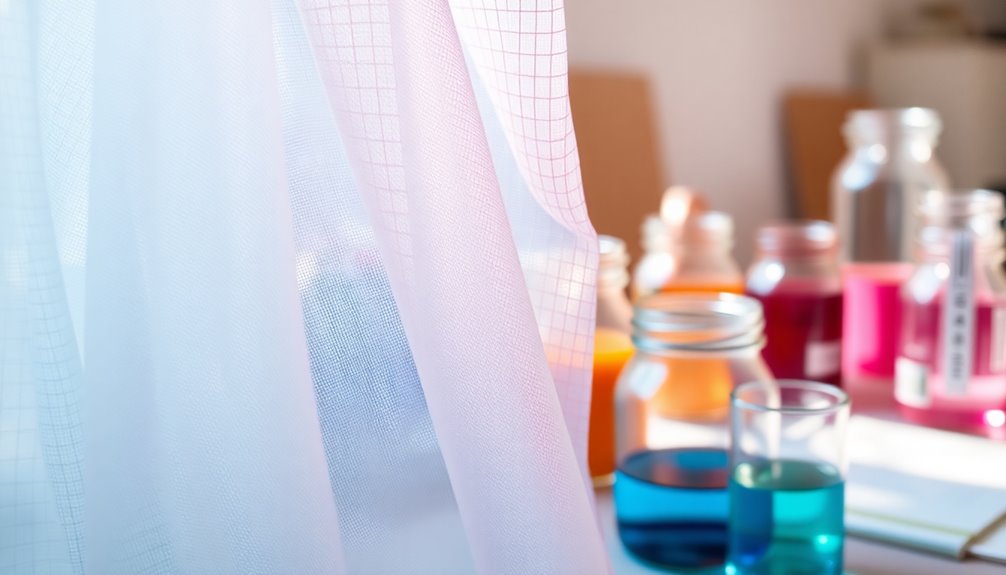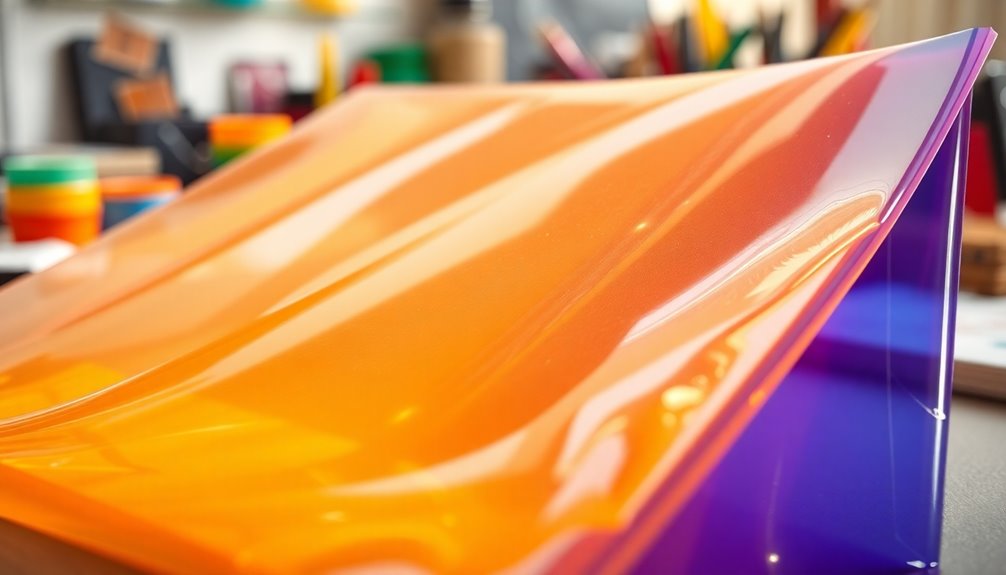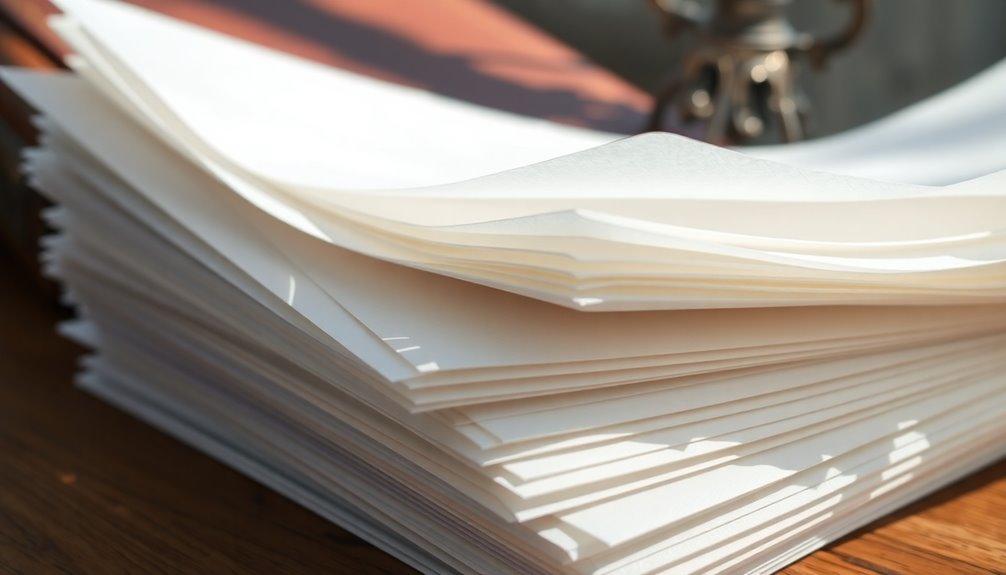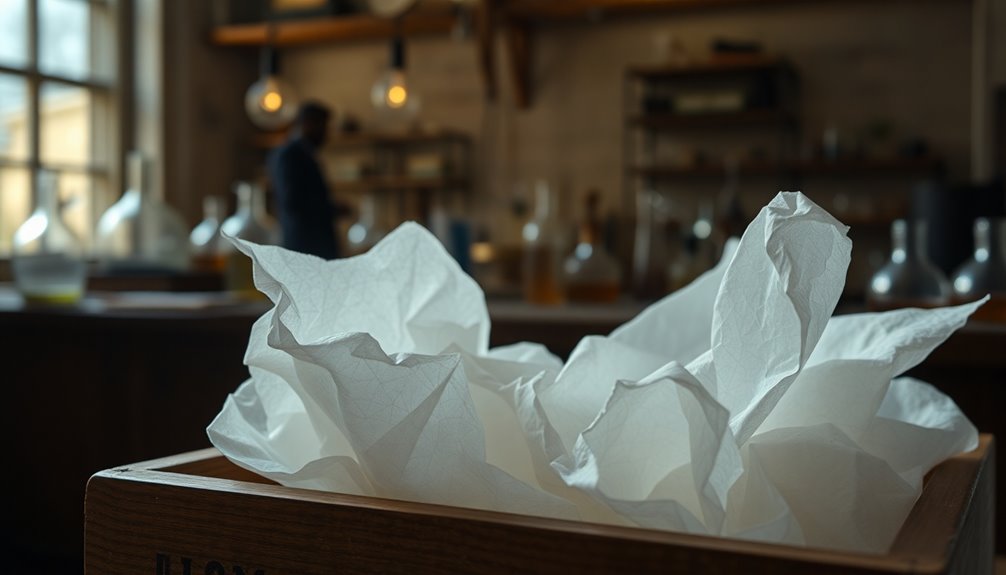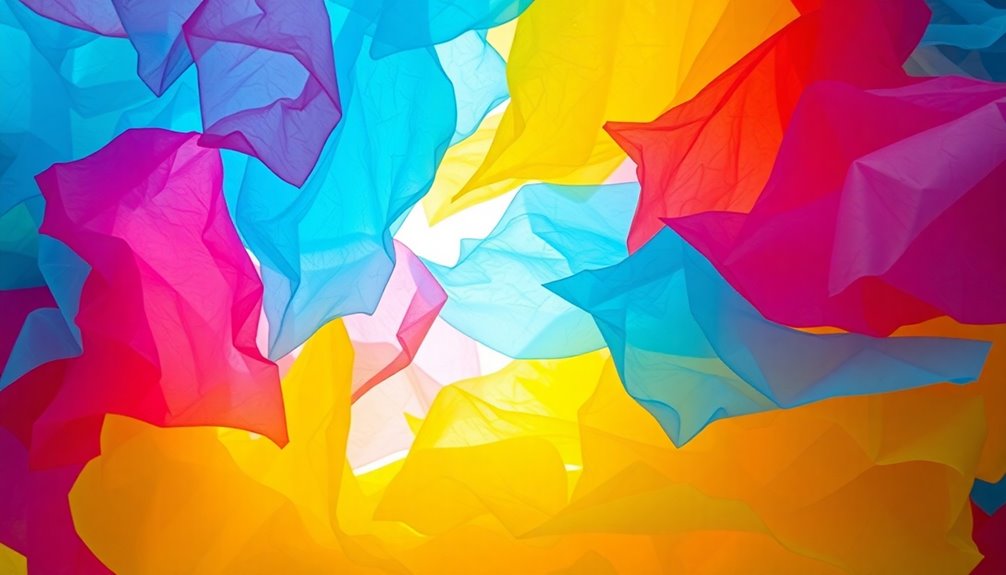If you're looking for substitutes for translucent paper, consider using vellum, which is smooth and ideal for invitations. Tracing paper is great for layering designs, while parchment adds a formal touch to documents. For a more modern look, specialty transparent films and clear plastic sheets are perfect for crafting and model making. Mylar offers excellent transparency and is easy to manipulate. You might also enjoy the texture and colors of tissue paper for creative projects. Each option has unique properties that can elevate your work, so keep exploring to find the perfect fit for your next creation.
Key Takeaways
- Vellum paper offers a sophisticated, durable option for invitations and crafts, compatible with inkjet and laser printers.
- Mylar provides exceptional transparency and durability, making it ideal for crafting, packaging, and light diffusion.
- Printable clear sheets allow for custom designs and unique transparent overlays, enhancing creativity in projects.
- Tissue paper adds texture and color, perfect for crafts and decorations at a cost-effective price.
- Specialty transparent films come in various finishes and are ideal for high-quality printing and light diffusion applications.
Alternatives to Translucent Paper
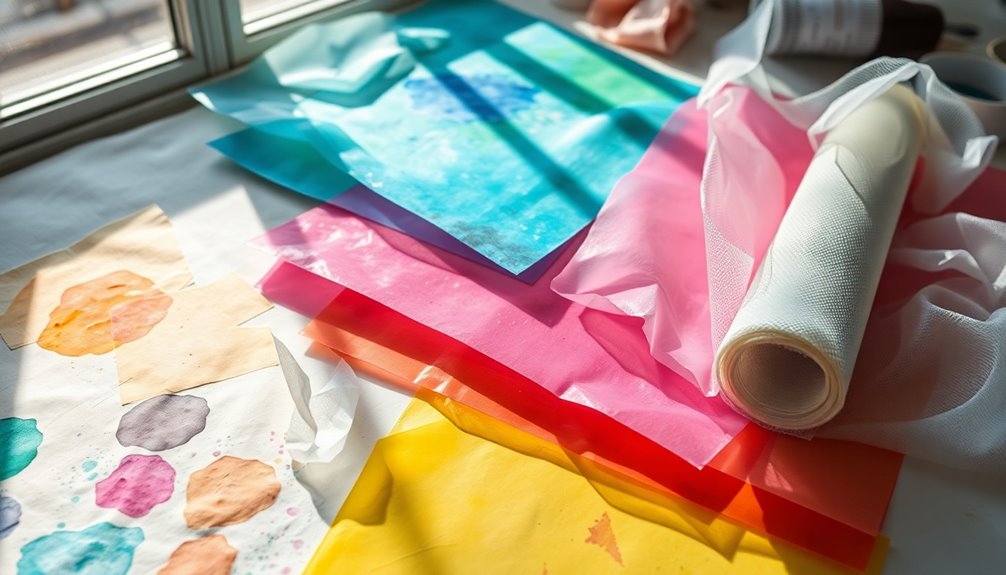
When you're looking for alternatives to translucent paper, several options stand out for their unique qualities.
Vellum paper is a top choice, known for its smooth texture and durability. Its translucency makes it perfect for invitations and various crafting projects, allowing for a sophisticated look without sacrificing strength.
Another great option is Mylar, a clear, durable material that excels in crafting and packaging. It provides excellent light diffusion and transparency, making it suitable for a range of applications.
If you're aiming for custom designs, consider using printable clear sheets. These sheets are compatible with inkjet or laser printers, enabling you to create unique transparent overlays.
Tissue paper is also worth exploring; while it's lightweight and semi-transparent, it adds a touch of texture and color, making it a versatile substitute for achieving translucent effects.
Finally, oiled paper can be a creative choice. Traditionally used in historical contexts, when treated properly, it can produce a translucent effect that enhances your projects.
Each of these alternatives offers its own distinct qualities, ensuring you find the right fit for your needs.
Exploring Vellum Paper
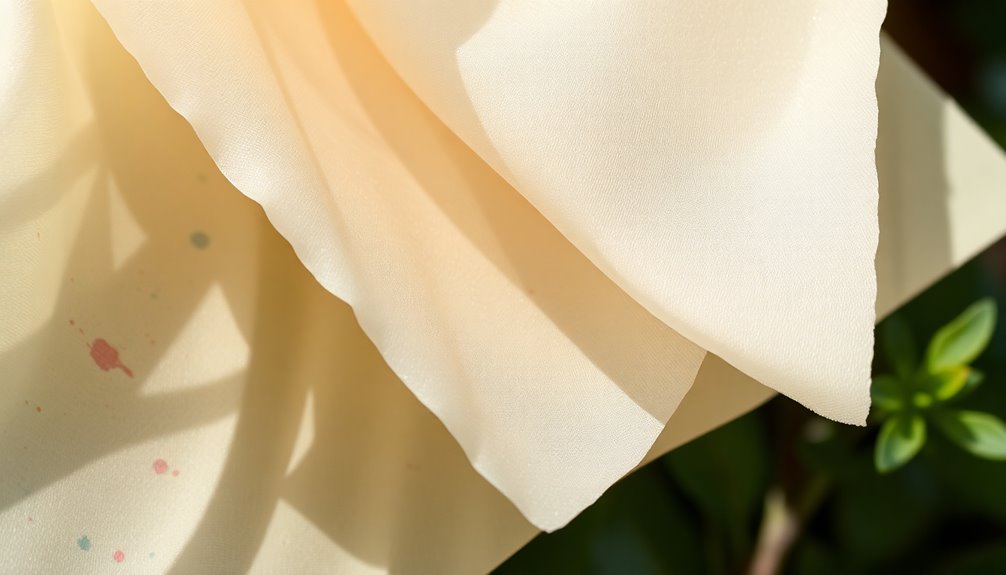
Although you might think of vellum as a traditional material, it's actually a modern, plant-based alternative that offers a unique blend of aesthetics and functionality. Vellum paper is primarily made from cellulose fibers, giving it a smooth, frosted glass-like appearance that enhances your projects while remaining durable.
One of the standout features of vellum is its versatility. It's available in a variety of colors, weights, and textures, making it perfect for stationery, invitations, and scrapbooking. You can easily print on vellum using both inkjet and laser printers, but it's wise to test for compatibility since different brands and weights may yield varying results.
The tactile experience of vellum is unmatched, providing a delightful touch to your creations. Plus, it withstands cutting and gluing techniques, making it an ideal choice for craft projects that require a translucent effect. Additionally, incorporating innovative solutions into your designs can further enhance the creative potential of your projects.
Whether you're layering it over other materials or using it as a standalone element, vellum can elevate your designs with its elegant appearance and reliable performance. So, if you're looking for an alternative to translucent paper, give vellum a try—it might just become your new favorite crafting companion!
Using Tracing Paper
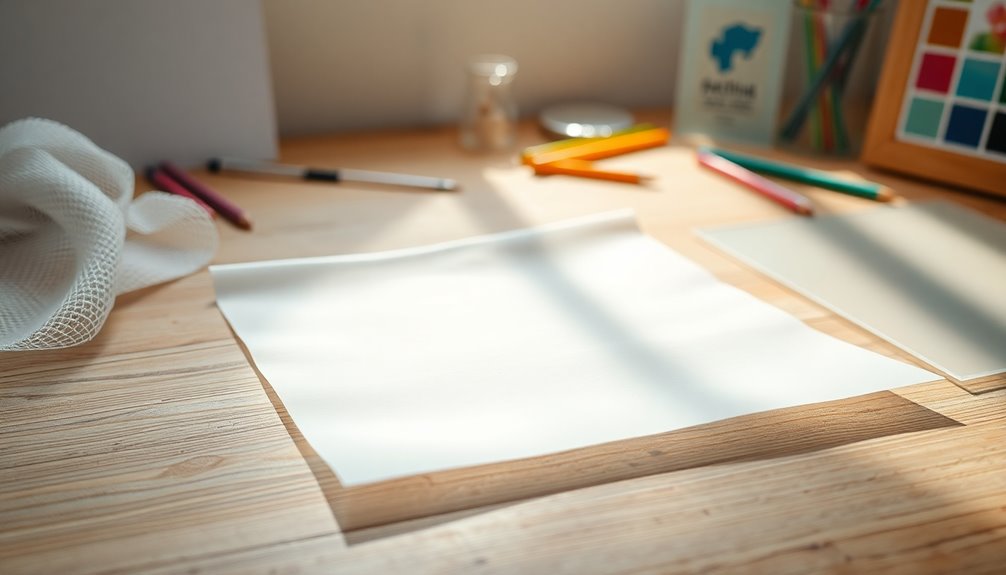
Tracing paper is a fantastic alternative to translucent paper, thanks to its unique properties that make it perfect for various artistic applications. You can use it for everything from sketching to layering designs, allowing your creativity to shine. Plus, it's compatible with most printers, so you can easily incorporate your designs into digital projects. Additionally, mastering sewing techniques can enhance your skills in creating unique handmade items that utilize tracing paper for patterns.
Properties of Tracing Paper
Using tracing paper opens up a world of creative possibilities for artists and designers. This translucent medium is crafted by chemically treating ordinary paper, breaking down wood fibers to create a lightweight yet durable material. Typically weighing around 25% of the original paper, tracing paper is available in various thicknesses, making it versatile for different artistic purposes.
The smooth finish of tracing paper provides an ideal surface for easy tracing and sketching, allowing you to create accurate representations of your ideas. You'll find that it absorbs ink differently than regular paper, which can impact your final output. To guarantee clarity, it's wise to test different ink types before committing to your design.
While translucent vellum is another option, tracing paper shines in fields like architecture, graphic design, and crafting. It's often used for making overlays, patterns, or detailed sketches, giving you the precision needed for various projects.
Applications in Art Projects
Artists have countless ways to incorporate tracing paper into their projects, thanks to its unique properties. This versatile material is perfect for sketching and transferring designs, allowing you to replicate images with precision.
Its translucency enables you to create stunning overlays in mixed media art projects, adding depth and texture by layering different elements.
Here are a few creative applications of tracing paper you might consider:
- Stencils and Templates: Use tracing paper to create stencils or templates that can be cut out for painting or drawing applications, giving you the freedom to explore various designs.
- Mixed Media Layers: Incorporate tracing paper into your mixed media pieces to achieve a beautiful layered effect, enhancing the visual complexity of your artwork.
- Unique Aesthetics: Combine tracing paper with other materials to simulate effects like stained glass, adding a distinctive touch to your creative projects.
The smooth surface of tracing paper works well with various mediums, including graphite, ink, and colored pencils.
As you experiment, you'll find that tracing paper enhances detail and clarity, making it an invaluable tool in your artistic journey.
Printing Techniques and Tips
When incorporating tracing paper into your printing projects, understanding its unique properties can greatly enhance your results. Tracing paper is lighter and stronger than regular paper, making it ideal for printing your designs. However, to achieve the best outcome, you need to select the right printing techniques.
Start by adjusting your inkjet printer settings to accommodate the lightweight and translucent qualities of tracing paper. This helps prevent smudging and paper jams. Testing various types of inks is also essential. Water-based inks behave differently than pigment-based inks when printed on tracing paper, so experiment to find what works best for your project.
Moreover, increase your printer's DPI (dots per inch) settings for higher resolution prints. This adjustment guarantees that fine details in your images are preserved, resulting in clearer prints.
After printing, allow sufficient drying time to prevent smearing, as tracing paper is more prone to smudging than standard paper types.
Benefits of Parchment
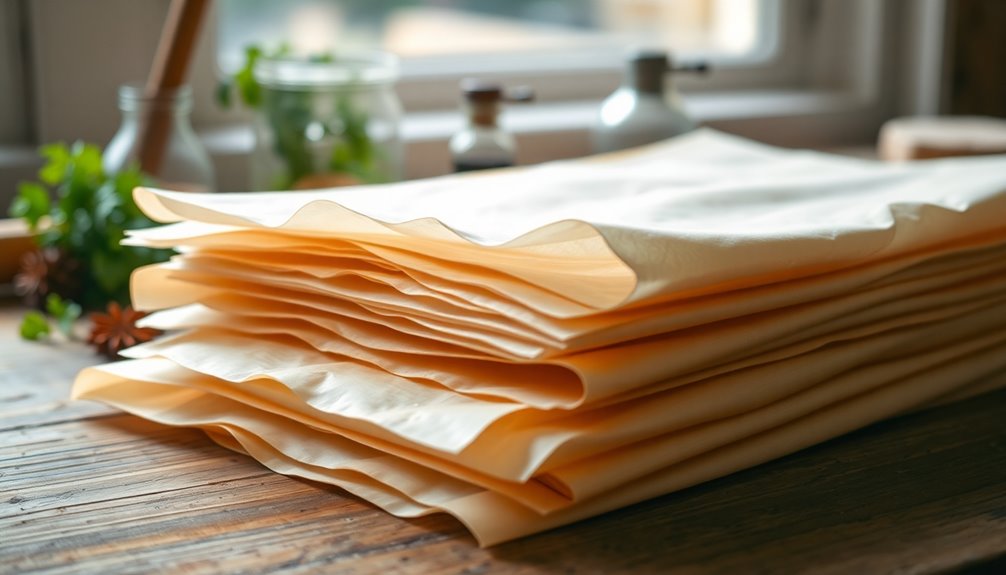
When you consider parchment for your projects, you'll appreciate its unique texture and slightly cloudy appearance that adds a special touch.
It's a versatile choice for crafting, calligraphy, and even baking, making it a cost-effective option for various applications.
Plus, its durability means you can rely on it for high-quality results without worrying about tears or ink bleed.
Unique Textural Qualities
Parchment paper stands out with its unique texture that offers both elegance and sophistication, making it a favored choice for various projects. Its heavier, tactile feel distinguishes it from standard translucent papers and enhances your creations with a touch of class.
The slightly cloudy appearance of parchment provides a softer diffusion of light, ensuring your designs have an inviting glow.
Here are some reasons why you might love using parchment paper:
- Durability: It resists tearing, making it perfect for cutting, gluing, or heat embossing.
- Ink Absorption: The unique surface allows for crisp and vibrant prints, enhancing your artistic endeavors.
- Classic Aesthetic: Limited in colors, typically white and ivory, it's ideal for formal documents like invitations and certificates.
Whether you're crafting invitations, artworks, or other projects, parchment paper not only adds a unique finish but also elevates the overall look and feel.
Its combination of durability and elegance makes it a versatile choice that can meet various artistic and functional needs. When you choose parchment, you're choosing quality and refinement for your creations. Additionally, using essential oils for diverse purposes can enhance your creative atmosphere and overall well-being while you work.
Versatile Crafting Applications
With its impressive durability and unique texture, parchment paper opens up a world of versatile crafting applications that can enhance any project. This remarkable material is especially beneficial for calligraphy and formal invitations, offering a refined look that makes your work stand out. Available in various weights, typically around 24lb, it provides a sturdy option for all your crafting projects.
One of the standout features of parchment paper is its slightly cloudy appearance, which allows you to create layered designs without overwhelming transparency. This quality makes it perfect for scrapbook pages or decorative overlays.
Plus, its resistance to ink bleeding guarantees that your detailed artwork remains crisp and clear, bringing your creative visions to life.
Whether you're printing invitations or designing custom cards, parchment paper's versatility makes it a go-to choice. You'll appreciate how it balances affordability with quality, allowing you to tackle larger projects or bulk crafting needs without breaking the bank.
Embrace the crafting possibilities that parchment paper offers, and elevate your projects with this exceptional alternative to translucent paper.
Cost-Effective Alternative Options
For anyone looking to save on crafting supplies, parchment paper stands out as a budget-friendly alternative to translucent options. This versatile material offers a semi-translucent quality similar to traditional translucent paper, making it perfect for various projects.
One of the best parts? Parchment paper is often more durable and resistant to tearing, so you won't have to worry about accidental rips during your creative process.
Here are some benefits of using parchment paper:
- Ink Absorption: It absorbs ink well, providing a smooth writing experience and enhancing the clarity of your printed materials.
- Variety of Weights: Parchment comes in multiple thicknesses, allowing you to select the perfect weight for your specific needs—whether lightweight crafting or sturdier applications.
- Cost Savings: You can usually find parchment paper at lower price points than specialized translucent papers, making it an economical choice for large-scale projects or frequent use. Additionally, using parchment paper can be an effective way to achieve energy-efficient options that reduce waste during your crafting process.
Clear Plastic Sheets

Clear plastic sheets offer a versatile solution for various projects that require a touch of translucency. Available in thicknesses ranging from 0.01 to 0.10 inches, these sheets cater to a wide range of applications, whether you're crafting, model making, or designing architectural elements.
You can choose from materials like mylar, acrylic, and polycarbonate, each providing unique levels of durability and clarity.
One of the great things about clear plastic sheets is their ease of use. You can cut them with scissors or a utility knife, allowing you to customize shapes and sizes to fit your needs. Plus, they can simulate glass or create protective barriers while still allowing light to pass through, making them perfect for creative projects.
If you're looking to add a printed design, clear plastic sheets are compatible with both inkjet and laser printers. Just make sure to test your printing method to guarantee proper adhesion and print quality.
With their flexibility and clarity, clear plastic sheets are an excellent alternative to translucent paper for your next project.
Thin Fabrics for Crafts
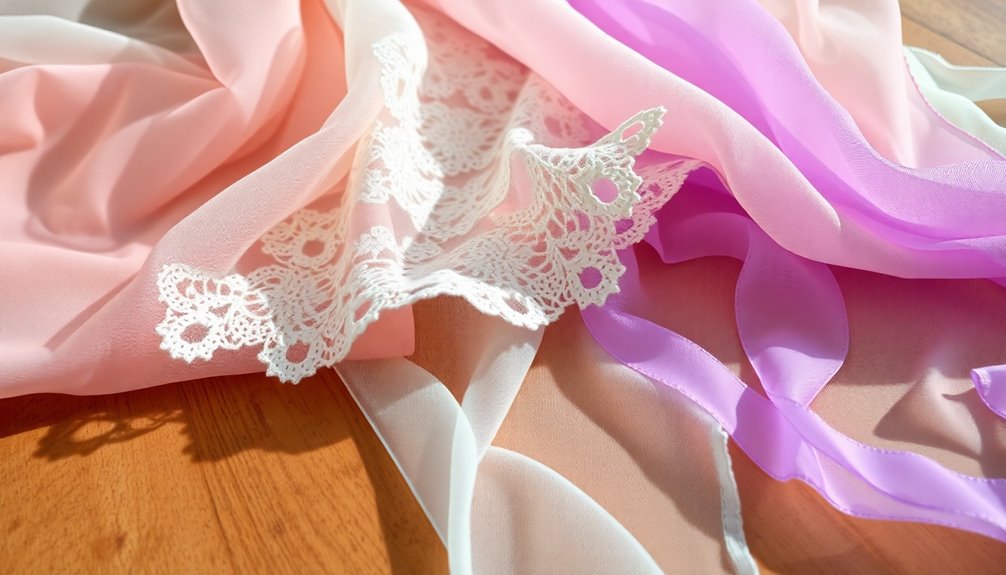
When it comes to adding a touch of elegance and translucency to your crafts, thin fabrics like organza, tulle, and chiffon stand out as excellent alternatives to traditional translucent paper.
These materials not only provide a delicate aesthetic but also enhance your projects in unique ways.
- Organza: This lightweight, sheer fabric is perfect for gift wrapping and embellishing, offering an eye-catching translucent effect.
- Tulle: With its fine netting texture, tulle is ideal for creating soft, airy decorations that allow light to filter beautifully through.
- Chiffon: Known for its graceful drape, chiffon adds a semi-transparent layer to creative projects, such as window treatments or floral arrangements.
While organza and the others shine in their own right, consider using muslin for a softer appearance, or lace to introduce texture and elegance. Additionally, using these fabrics can enhance the overall financial security of your craft projects by allowing for more creative and cost-effective designs.
Just remember, these thin fabrics can often replace tissue paper in various crafts, giving you more versatility and style in your creative endeavors.
Specialty Transparent Films
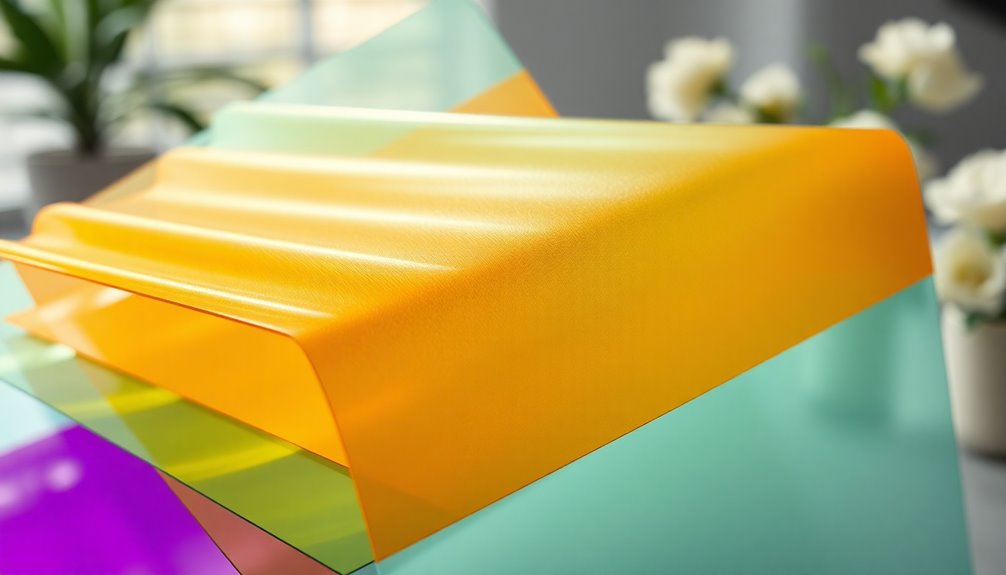
Crafting with specialty transparent films opens up a world of possibilities that thin fabrics can't fully achieve. Available in various thicknesses and finishes like matte, glossy, and frosted, these films cater to diverse artistic and professional needs.
You'll find that they offer superior durability compared to traditional translucent papers, making them perfect for projects requiring long-lasting results.
Many specialty transparent films are compatible with both inkjet and laser printers, enabling you to achieve high-quality printing of images and text without hassle. If you're looking to enhance visual effects, some films are specifically designed for light diffusion, which is ideal for applications such as lighting fixtures and architectural models.
One of the best features of specialty transparent films is their versatility. You can easily cut and manipulate them, giving you the freedom to experiment and create unique designs. Additionally, incorporating essential oils for aromatherapy can enhance the overall sensory experience of your projects.
Whether you're working on a crafting project or a professional presentation, these films elevate your work beyond what standard translucent paper can offer. Embrace the potential of specialty transparent films and transform your creative endeavors today!
Enhancing With Tissue Paper
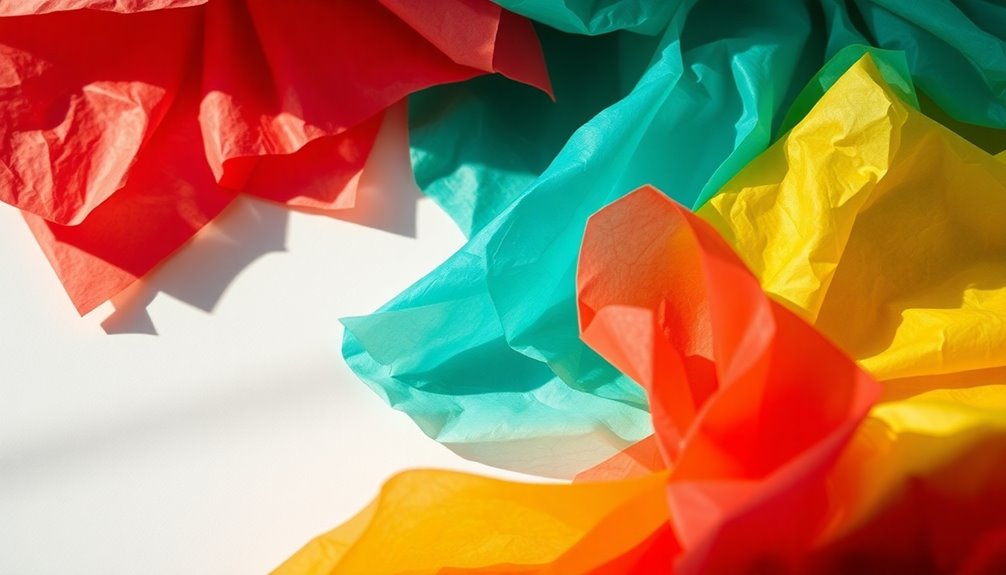
How can you elevate your projects with tissue paper? This lightweight, semi-transparent material is an excellent alternative to translucent paper, perfect for adding layers and depth to your craft projects.
When using colored tissue paper, you can create stunning gradients and effects that enhance the visual appeal of your art pieces.
Here are a few ways to make the most of tissue paper:
- Layering: Combine different colors to achieve beautiful shifts.
- Ink bleed-through: Utilize this feature for soft designs in collages or prints.
- Cost-effective: Tissue paper is often cheaper than specialty translucent papers, allowing you to work on larger projects without breaking the bank.
Creative Applications of Mylar
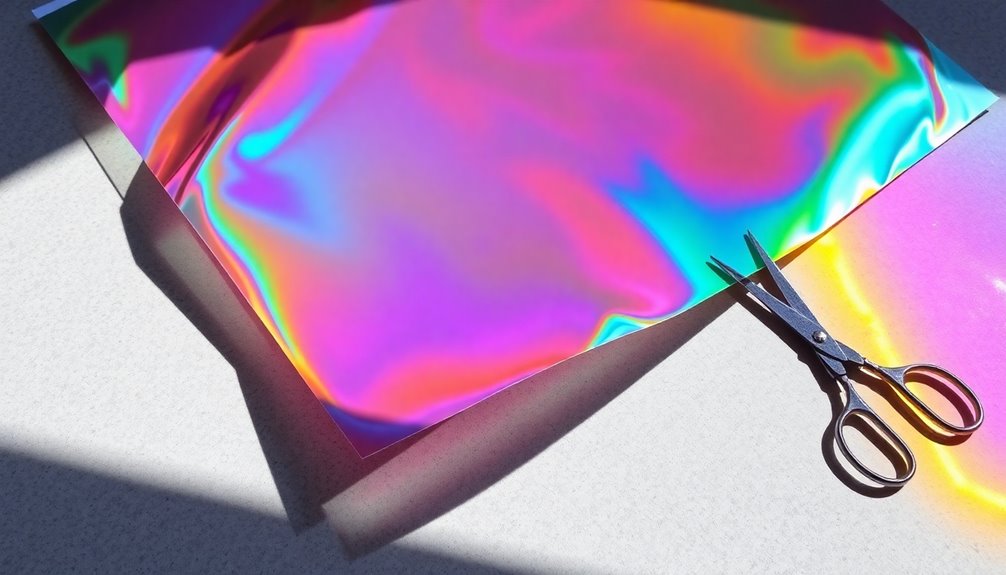
Mylar offers a world of creative possibilities for your projects, thanks to its strength and high transparency. This exceptional polyester film is a fantastic alternative to traditional translucent paper in crafting and design. You'll find Mylar particularly useful for creating durable stencils, protective covers, and overlays that can withstand wear and tear.
Here's a quick overview of Mylar's creative applications:
| Application | Benefits | Tips |
|---|---|---|
| Stencils | Durable and reusable | Use a craft knife for precision |
| Custom Printing | Clarity and vibrancy | Compatible with inkjet/laser |
| Decorative Accents | Reflective and eye-catching | Experiment with colors |
Whether you're designing invitations, signage, or artwork, Mylar guarantees your creations stand out. Plus, its reflective surface enhances projects like scrapbooking or lampshades, creating shiny accents and improving light diffusion. Available in various thicknesses and finishes, Mylar is easy to cut, shape, and adhere, making it a versatile choice for both professionals and hobbyists. Embrace Mylar and elevate your creative projects today!
Techniques for Layering Materials
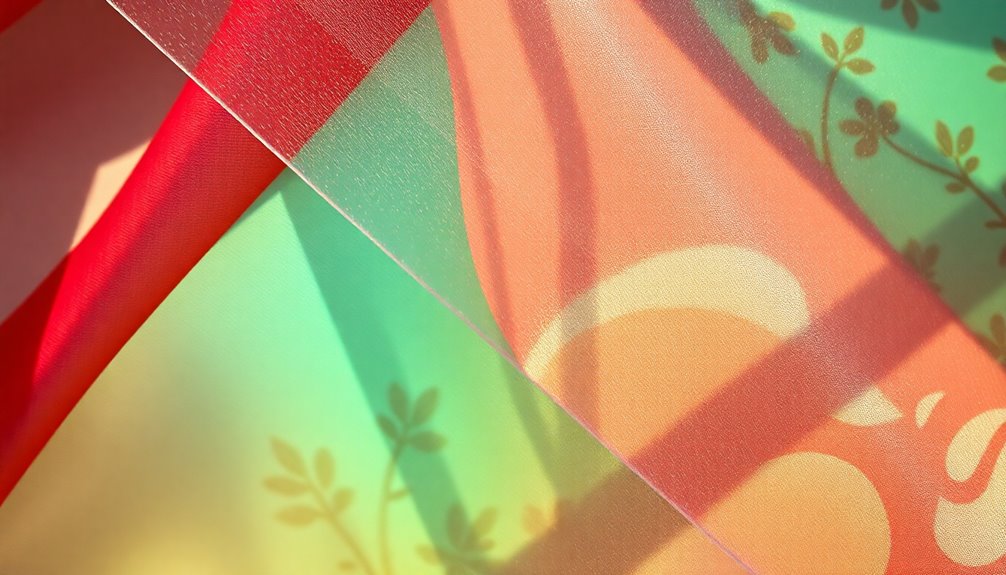
Layering materials opens up exciting possibilities for enhancing translucency in your projects. By experimenting with different types of paper, like tissue paper or lightweight gift wrap, you can create unique translucency effects. The thickness and texture of each layer affect how much light passes through, giving you control over the final look.
Here are some techniques to try:
- Combine transparent films, such as mylar or printable clear sheets, to enhance translucency while providing a smooth surface for your designs.
- Use oils like linseed or coconut oil on paper to achieve a beautiful translucent quality, while discovering how these oils change the material's appearance and durability.
- Incorporate clear adhesive sheets between layers to add depth and visual effects, while also protecting your work from moisture and handling.
You can also apply acrylic mediums or water-based inks to modify the opacity of your layered materials. This not only allows for creative designs but also improves light diffusion, making your projects truly stand out.
Embrace layering, and release your creativity with these materials!
Frequently Asked Questions
How to Make Translucent Paper at Home?
To make translucent paper at home, start by tearing paper scraps like tissue or newspaper into small pieces.
Mix white glue with water to create a thin adhesive.
Layer the torn pieces onto a plastic baggie, applying the glue mixture between layers for adhesion.
Once you've reached your desired thickness, add a final coat of glue on top.
Let it dry for a few hours, then peel it off the baggie, and it's ready to use!
What Is a Substitute for Vellum Paper?
If you're looking for a substitute for vellum paper, consider using tracing paper.
It has a similar texture and translucency, making it perfect for sketching and design work.
Parchment paper is another option; while it's a bit cloudier, it offers a unique texture.
You might also try printable clear sheets or Mylar for durability and transparency.
Finally, layered tissue paper can create a delicate, translucent effect in your projects.
Is Parchment Paper Translucent?
Yes, parchment paper is semi-translucent, allowing some light to pass through but not as clearly as true vellum or tracing paper.
You'll find it useful for various projects, especially crafting, where you want a textured appearance.
While it isn't as strong as vellum, it can handle moderate use.
Plus, it's budget-friendly, making it a great choice if you're looking for an affordable alternative for your artistic endeavors.
What Can I Use in Place of Tracing Paper?
If you need an alternative to tracing paper, you've got several options.
Vellum paper works well, providing a smooth surface for your designs.
Baking paper is another affordable choice, as it allows ink to stay put without bleeding.
Clear plastic sheets, like mylar, are durable and reusable, while lightweight tissue paper can also serve for quick tracing tasks.
Finally, consider using clear plastic report covers for flexible tracing needs.
Conclusion
To summarize, you've got plenty of great alternatives to translucent paper at your fingertips. Whether you choose vellum, tracing paper, or even clear plastic sheets, each option offers unique qualities for your projects. Don't forget about creative materials like tissue paper and Mylar to add depth and texture. Experiment with layering techniques to achieve stunning effects. So, go ahead and explore these alternatives to elevate your creativity and bring your ideas to life!

